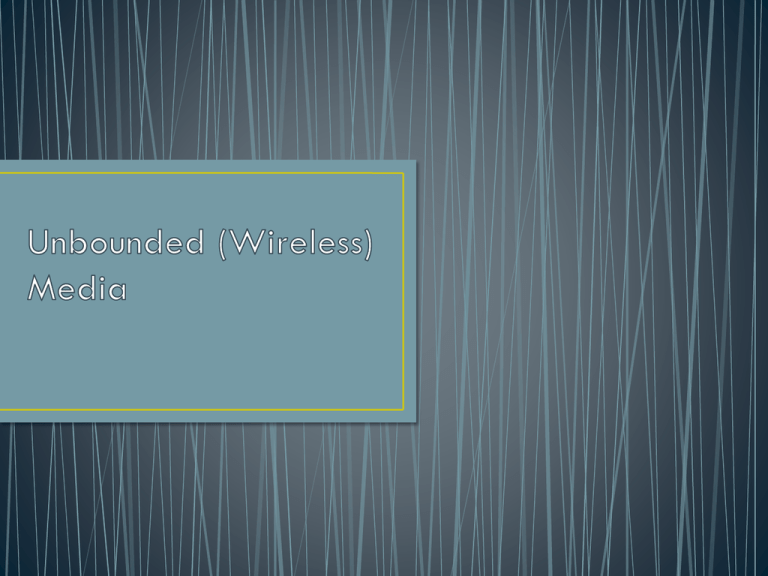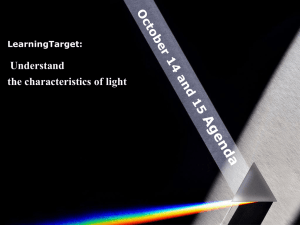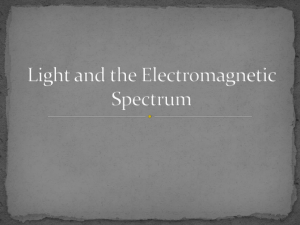Infrared Transmissions
advertisement

• Unbounded media have network signals that are not bound by any type of fiber or cable; hence, they are also called wireless technologies • Wireless LAN media are becoming extremely popular in modular office spaces. • Today’s networks aren’t composed of a single technology or wiring scheme—they are heterogeneous networks. • Wireless technologies are just one way of solving a particular networking need in a heterogeneous cabling system. Although cabled networks are generally less expensive, more robust transmission-wise, and faster (especially in the horizontal environment), in certain situations, wireless networks can carry data where traditional cabled networks cannot. This is particularly the case in backbone or WAN implementations. Everyone who has a television with a remote control has performed an infrared transmission. • It has a wavelength • shorter than visible light (actually, it’s shorter than the red wavelength in the visible spectrum) • with more energy. Infrared is a very popular method of wireless networking. The sections that • follow examine some of the details of infrared transmissions. • Infrared (IR) transmissions are signal transmissions that use infrared radiation as their transmission method. Infrared radiation is part of the electromagnetic spectrum. It has a wavelength shorter than visible light (actually, it’s shorter than the red wavelength in the visible spectrum) with more energy. Infrared is a very popular method of wireless networking. • Infrared transmissions are very simple. All infrared connections work similarly to LAN transmissions, except that no cable contains the signal. The infrared transmissions travel through the air and consist of infrared radiation that is modulated in order to encode the LAN data. • A laser diode, a small electronic device that can produce single wavelengths or frequencies of light or radiation, usually produces the infrared radiation. A laser diode differs from a regular laser in that it is much simpler, smaller, and lower powered; thus, the signals can only travel over shorter distances (usually less than 500 feet). • Besides needing an infrared transmitter, all devices that communicate via infrared need an infrared receiver. The receiver is often a photodiode, or a device that is sensitive to a particular wavelength of light or radiation and converts the infrared signals back into the digital signals that a computer will understand. •Cost •Installation •Capacity •Attenuation • • • • • • Relatively inexpensive High bandwidths No FCC license required Ease of installation High security on point-to-point connections Portability • Line of sight needed for focused transmissions. • Weather attenuation. • Radio-frequency (RF) transmission systems are those network transmission systems that use radio waves to transmit data. • 1999 • 2003 Radio waves have frequencies from 10 kilohertz (kHz) to 1 gigahertz (GHz), and RF systems use radio waves in this frequency band. The range of the electromagnetic spectrum from 10kHz to 1GHz is called radio frequency (RF). ADVANTAGES OF RF • No line of sight needed Radio waves can penetrate walls and other solid obstacles, so a direct line of sight is not required between sender and receiver. • Low cost Radio transmitters have been around since the early twentieth century. After 100 years, high-quality radio transmitters have become extremely cheap to manufacture. • Flexible Some RF LAN systems allow laptop computers with wireless PC NICs to roam around the room while remaining connected to the host LAN. DISADVANTAGES OF RF • Susceptible to jamming and eavesdropping Because RF signals are broadcast in all directions, it is very easy for someone to intercept and interpret a LAN transmission without the permission of the sender or receiver. Those RF systems that use spread-spectrum encoding are less susceptible to this problem. • Susceptible to RF interference All mechanical devices with electric motors produce stray RF signals, known as RF noise. The larger the motor, the stronger the RF noise. These stray RF signals can interfere with the proper operation of an RF-transmission LAN. • Limited range RF systems don’t have the range of satellite networks (although they can travel longer distances than infrared networks). Because of their limited range, RF systems are normally used for short-range network applications (e.g., from a PC to a bridge, or shortdistance building-to-building applications). • Microwave communication makes use of the lower gigahertz frequencies of the electromagnetic spectrum. These frequencies, which are higher than radio frequencies, produce better throughput and performance than other types of wireless communications. • Terrestrial microwave systems typically use directional parabolic antennas to send and receive signals in the lower gigahertz frequency range. The signals are highly focused and must travel along a line-of-sight path. Relay towers extend signals. Terrestrial microwave systems are typically used when the cost of cabling is cost-prohibitive. • • • • • Frequency range Cost Capacity Attenuation EMI • Satellite microwave systems transmit signals between directional parabolic antennas. Like terrestrial microwave systems, they use low gigahertz frequencies and must be in line of sight. The main difference with satellite systems is that one antenna is on a satellite in geosynchronous orbit about 50,000 kilometers (22,300 miles) above the earth. Therefore, satellite microwave systems can reach the most remote places on earth and communicate with mobile devices. • • • • • Frequency range Cost Capacity Attenuation EMI • Very high bandwidth • Transmissions travel over long distances • Signals can be point-to-point or broadcast • • • • • Equipment is expensive Line of sight required Atmospheric attenuation Propagation delay Safety • Microwave equipment differs from infrared and RF equipment because it is more specialized and is usually only used for WAN connections.






